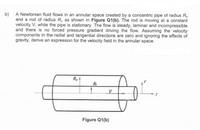
Elements Of Electromagnetics
7th Edition
ISBN: 9780190698614
Author: Sadiku, Matthew N. O.
Publisher: Oxford University Press
expand_more
expand_more
format_list_bulleted
Concept explainers
Question

Transcribed Image Text:b)
A Newtonian fluid flows in an annular space created by a concentric pipe of radius R,
and a rod of radius R;, as shown in Figure Q1(b). The rod is moving at a constant
velocity V, while the pipe is stationary. The flow is steady, laminar and incompressible
and there is no forced pressure gradient driving the flow. Assuming the velocity
components in the radial and tangential directions are zero and ignoring the effects of
gravity, derive an expression for the velocity field in the annular space.
R.
R:
Figure Q1(b)
Expert Solution
This question has been solved!
Explore an expertly crafted, step-by-step solution for a thorough understanding of key concepts.
This is a popular solution
Trending nowThis is a popular solution!
Step by stepSolved in 2 steps with 2 images

Knowledge Booster
Learn more about
Need a deep-dive on the concept behind this application? Look no further. Learn more about this topic, mechanical-engineering and related others by exploring similar questions and additional content below.Similar questions
- I am confused whether points A and B do not lie on the same streamline in this equation.arrow_forwardA Newtonian fluid is flowing in the narrow gap between two infinite parallel horizontal plates due to the movement of the top plate (see the figure below). The top plate is moving at a speed U from left to right, and the bottom plate is stationary. Consider the flow is steady, incompressible, and laminar. The distance between two plate is H, and the gravity acts in negative z-direction (which is perpendicular into the page). There is an applied constant pressure gradient of apJəx in the x-direction. Calculate the velocity and pressure fields. Plot typical velocity profiles in dimensionless form for a pressure gradient value of 0 and -15. In your solution show the conceptual diagram of the problem; write all relevant assumptions and boundary conditions; show the detailed steps of the problem solutions including equations and detailed processing of those equations. Moving plate Fluid: p.H Fixed plate P2-P1arrow_forwardIn plane stagnation flow, an incompressible fluid occupying the space y>0 has one velocity component given by Vx-x. The flow is two-dimensional and steady, such that V₂=0 and nothing depends on z or time t. (a) Use the continuity equation to determine Vy(x,y), given that Vy(x,0) =0. (This condition for Vy corresponds to the plane y=0 being an impenetrable boundary.) (b) is arbitrary, so you may set Y=0 at any convenient location.) Determine the stream function for this flow, (x,y). (The absolute value ofarrow_forward
- P3.5 Water at 20°C flows through a 5-in-diameter smooth pipe at a high Reynolds number, for which the velocity profile is approximated by u = U.(v/R)/8, where U, is the cen- terline velocity, R is the pipe radius, and y is the distance measured from the wall toward the centerline. If the cen- terline velocity is 25 ft/s, estimate the volume flow rate in gallons per minute.arrow_forwardPlease help me with this question with details. i need answer of these questions with explanation.arrow_forward
arrow_back_ios
arrow_forward_ios
Recommended textbooks for you
 Elements Of ElectromagneticsMechanical EngineeringISBN:9780190698614Author:Sadiku, Matthew N. O.Publisher:Oxford University Press
Elements Of ElectromagneticsMechanical EngineeringISBN:9780190698614Author:Sadiku, Matthew N. O.Publisher:Oxford University Press Mechanics of Materials (10th Edition)Mechanical EngineeringISBN:9780134319650Author:Russell C. HibbelerPublisher:PEARSON
Mechanics of Materials (10th Edition)Mechanical EngineeringISBN:9780134319650Author:Russell C. HibbelerPublisher:PEARSON Thermodynamics: An Engineering ApproachMechanical EngineeringISBN:9781259822674Author:Yunus A. Cengel Dr., Michael A. BolesPublisher:McGraw-Hill Education
Thermodynamics: An Engineering ApproachMechanical EngineeringISBN:9781259822674Author:Yunus A. Cengel Dr., Michael A. BolesPublisher:McGraw-Hill Education Control Systems EngineeringMechanical EngineeringISBN:9781118170519Author:Norman S. NisePublisher:WILEY
Control Systems EngineeringMechanical EngineeringISBN:9781118170519Author:Norman S. NisePublisher:WILEY Mechanics of Materials (MindTap Course List)Mechanical EngineeringISBN:9781337093347Author:Barry J. Goodno, James M. GerePublisher:Cengage Learning
Mechanics of Materials (MindTap Course List)Mechanical EngineeringISBN:9781337093347Author:Barry J. Goodno, James M. GerePublisher:Cengage Learning Engineering Mechanics: StaticsMechanical EngineeringISBN:9781118807330Author:James L. Meriam, L. G. Kraige, J. N. BoltonPublisher:WILEY
Engineering Mechanics: StaticsMechanical EngineeringISBN:9781118807330Author:James L. Meriam, L. G. Kraige, J. N. BoltonPublisher:WILEY

Elements Of Electromagnetics
Mechanical Engineering
ISBN:9780190698614
Author:Sadiku, Matthew N. O.
Publisher:Oxford University Press

Mechanics of Materials (10th Edition)
Mechanical Engineering
ISBN:9780134319650
Author:Russell C. Hibbeler
Publisher:PEARSON

Thermodynamics: An Engineering Approach
Mechanical Engineering
ISBN:9781259822674
Author:Yunus A. Cengel Dr., Michael A. Boles
Publisher:McGraw-Hill Education

Control Systems Engineering
Mechanical Engineering
ISBN:9781118170519
Author:Norman S. Nise
Publisher:WILEY

Mechanics of Materials (MindTap Course List)
Mechanical Engineering
ISBN:9781337093347
Author:Barry J. Goodno, James M. Gere
Publisher:Cengage Learning

Engineering Mechanics: Statics
Mechanical Engineering
ISBN:9781118807330
Author:James L. Meriam, L. G. Kraige, J. N. Bolton
Publisher:WILEY